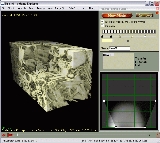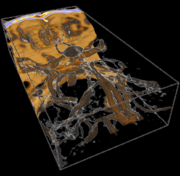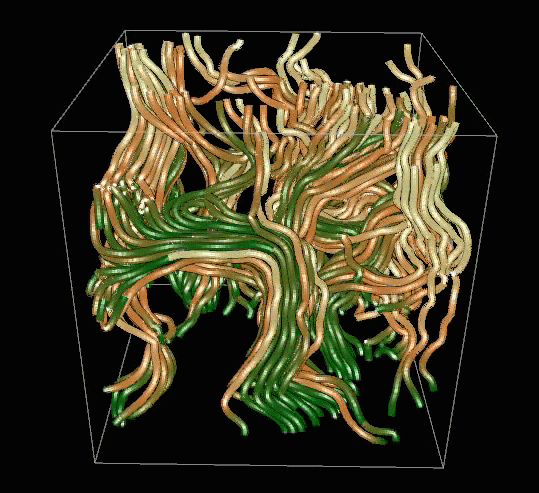
Drishti
Encyclopedia
Drishti is a multi-platform, open-source
Volume Exploration and Presentation Tool. It was written for visualizing tomography data, electron-microscopy data and so forth. It aims to ease understanding of the data set and to assist with conveying that understanding to the research community or a lay person. From the website:
It has been used by the CSIRO for a number of purposes, such as volumetric visualisation of various computer tomography datasets. The Australian National University (ANU) Physics department, along with the author of the software, have used it for, amongst other things, the analysis of immiscible flow in massive 3D systems. Further uses will be presented at APAC
'07 .

 Drishti provides a number of features that would otherwise require several proprietary volume visualisation programs or that are simply not available together in other software:
Drishti provides a number of features that would otherwise require several proprietary volume visualisation programs or that are simply not available together in other software:
Open-source software
Open-source software is computer software that is available in source code form: the source code and certain other rights normally reserved for copyright holders are provided under a software license that permits users to study, change, improve and at times also to distribute the software.Open...
Volume Exploration and Presentation Tool. It was written for visualizing tomography data, electron-microscopy data and so forth. It aims to ease understanding of the data set and to assist with conveying that understanding to the research community or a lay person. From the website:
"The central idea about Drishti is that the scientists should be able to use it for exploring volumetric datasets as well as use it in presentations."
It has been used by the CSIRO for a number of purposes, such as volumetric visualisation of various computer tomography datasets. The Australian National University (ANU) Physics department, along with the author of the software, have used it for, amongst other things, the analysis of immiscible flow in massive 3D systems. Further uses will be presented at APAC
Australian Partnership for Advanced Computing
The Australian Partnership for Advanced Computing was created by the Department of Education, Science and Training in order to provide advanced computing and grid infrastructure for Australian research communities...
'07 .
Features


- volume renderingVolume renderingIn scientific visualization and computer graphics, volume rendering is a set of techniques used to display a 2D projection of a 3D discretely sampled data set.A typical 3D data set is a group of 2D slice images acquired by aCT, MRI, or MicroCT scanner....
: drawing a scalar function defined over a volumetric region of space with some translucent appearance so that the interior of the dataset can be observed. - 2D Transfer functionTransfer functionA transfer function is a mathematical representation, in terms of spatial or temporal frequency, of the relation between the input and output of a linear time-invariant system. With optical imaging devices, for example, it is the Fourier transform of the point spread function i.e...
s (or Lookup tableLookup tableIn computer science, a lookup table is a data structure, usually an array or associative array, often used to replace a runtime computation with a simpler array indexing operation. The savings in terms of processing time can be significant, since retrieving a value from memory is often faster than...
s): In addition to, or instead of thresholding, Drishti allows the user to apply transfer functions across "density" or "value" as well as gradient. - clippingClipping (computer graphics)Any procedure which identifies that portion of a picture which is either inside or outside a picture is referred to as a clipping algorithm or clipping.The region against which an object is to be clipped is called clipping window.-Examples:...
: removing some spatial region from a dataset. - StreamlinesStreamlines, streaklines and pathlinesFluid flow is characterized by a velocity vector field in three-dimensional space, within the framework of continuum mechanics. Streamlines, streaklines and pathlines are field lines resulting from this vector field description of the flow...
- MaskingMaskingIn art, craft, and engineering, masking is the use of materials to protect areas from change, or to focus change on other areas.Masking can describe either the techniques and materials used to control the development of a work of art by protecting a desired area from change; or a phenomenon that ...
- Brick Animations
- Realtime animation and movie export with:
- camera choreography (camera position, pan, rotation, zoom, etc.)
- transfer-function choreography
- time series choreography
- sub-volume choreography
- Importing DICOM image stack in addition to the current raw and processed (netCDFNetCDFNetCDF is a set of software libraries and self-describing, machine-independent data formats that support the creation, access, and sharing of array-oriented scientific data. The project homepage is hosted by the Unidata program at the University Corporation for Atmospheric Research...
) volume file formats. - Tensor visualization using superellipsoids
- Network (Graph) visualization
- Remap facility for remapping 16/32 bit volumes to 8 bit volumes
- Cropping and scaling facility for image stacks
- Cropping and scaling facility for RAW volumes
- Saving movies from the program

